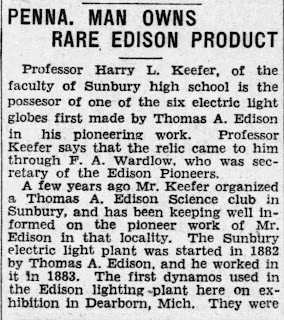This Edison Motor at the Smithsonian Museum came from a classroom in Sunbury Pa.
A young man when Edison ran his electric lights in Sunbury, Harry Keefer collaborated with his brother, Samuel , to write about Edison's time in Sunbury. The brothers submitted the paper to Edison's laboratory for verification, and were in return invited to visit. This began a life long friendship between Harry Keefer and Thomas Edison.
In 1919, when Mr. Keefer began his teaching career at Sunbury, he organized the Thomas A. Edison Science Club, the first of it's kind in the world. It was Mr, Keefer who, on behalf of the town, invited Mr. Edison to return to Sunbury for the Sesquicentennial event in 1922.
In 1919, when Mr. Keefer began his teaching career at Sunbury, he organized the Thomas A. Edison Science Club, the first of it's kind in the world. It was Mr, Keefer who, on behalf of the town, invited Mr. Edison to return to Sunbury for the Sesquicentennial event in 1922.
In the above photo, Harry Keefer stands to the right of Edison
James Weber was a student at Sunbury high school, and he assisted Keefer in science class demonstrations. He remembered that Keeper used the motor as a model in his classroom. Weber and Keefer stayed in touch after graduation, and later in life Mr. Keefer gifted the motor to Weber. "because I know you are interested in these things". Weber later donated the motor to the Smithsonian Institute.
A cardboard label accompanying the motor states : "Electric motor. Used in early experimenting at Edison's Sunbury Plant E. Vine St. near N. Fourth St."
Hal Wallace, Assistant Curator of Electricity Collections at the National Museum Of American History states that this motor was very rudimentary for Edison in 1883. He theorizes that this engine may have been used to teach the very basics to the locals who needed to run the plant, but who had no experience with the machines needed to run them.
Louis Carlat editor of the Edison Papers Staff at Rutgers, wrote, “concerns about the capability of local skilled and semiskilled labor to operate the machinery with only a few weeks of training would haunt [Edison’s] experience not only at Sunbury but in a number of other plants.” (p. 312)
Salvaged from the junk heap- the dynamos used by Thomas Edison
In Sunbury Pa.
But the motor at the Smithsonian is not the only Edison creation Keefer has preserved. He is also credited with "saving from the junk heap the crude original dynamo built by Edison in connection with his Sunbury experiments. The cumbersome 'heart' of his Sunbury experiments has been stored for years in the car barn of the S and N Transit Co. on Railroad, now Edison Avenue.
It's value was unknown, with the result that it was earmarked for sale to a scrap dealer, but the Messrs Keefer were responsible for it's preservation and removal to the Ford Museum in Dearborn Michigan."
(An earlier newspaper article states that the dynamo was briefly at the Ford Museum, but it now resides at the Franklin Institute in Philadelphia)
(An earlier newspaper article states that the dynamo was briefly at the Ford Museum, but it now resides at the Franklin Institute in Philadelphia)
March 1929
Allentown Morning Call
Keefer also owned one of the 6 electric light globes first made by Edison.
The Obituary of Former Sunbury Science Teacher,
and Close Friend Of Thomas Edison,
Harry L. Keefer
The Edison Papers, on The rutgers website, note two separate letters, in 1916, from Harry to Edison, but images are not available for either correspondence.
The Sunbury Daily Item
May 2 1953
"During his last two years in high school, Mr. Keefer and his brother Samuel collaborated to write a paper about Edison, dealing specifically with the period the inventor spent in Sunbury perfecting the incandescent electric lamp for commercial use. Later the Keefers send the paper to Edison for verification and soon after that Harry was invited to visit the Edison laboratories.
When Mr. Keefer resumed teaching here in 1919, he organized the Thomas A. Edison Science Club, the first of it's kind in the world. The club was made up of boys eager to broaden their knowledge of sciences and willing to devote much time to this extra curricular activity. The membership never exceeded 15 and the meetings, devoted to experimentation and research, were held a the homes of different members.
Edison became and honorary member of the local club, and during an anniversary of the organization came to Sunbury and spent two and one-half hours with the boys. Similar organizations cropped up throughout the country." The article above goes on to list many of the Science Club members and the careers they went on to obtain.
(Same photo as above, but from a different paper, with a different caption)
March 14 1922
Read More:












No comments:
Post a Comment
I'll read the comments and approve them to post as soon as I can! Thanks for stopping by!